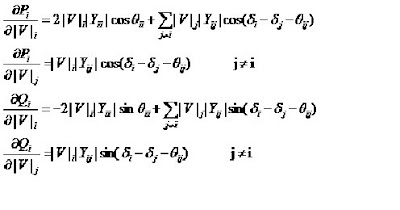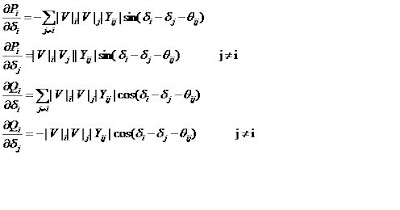1.1 INTRODUCTION
The load flow study reveals the electrical performance and power flow (real and reactive) for specified conditions when the system is operating under steady-state [1]. Load flow study commonly used iterative techniques for the solution of non linear algebraic equation. These technique are applied to the practical systems using the develop software modules [2].
The program of load flow analysis of Newton-Raphson method will be done using the component based methodology. Component based development is reusable and can increase the efficiency of commercial offering of power system software.
The advantage of the component web based is that the component can be installed into integrated development environment (IDE) and simplifies system maintenance and modifications [3, 4].
Since each on the components is loosely coupled, users are free to upgrade and/or add components as needed without affecting other parts of the system. And since a component can be built and then continuously improved upon by an expert of organization the quality of a component based application will improve over time [3].
Component based system is link with content management system (CMS) Joomla!. Joomla! is using the open CMS such as PHP language and MySQL database [4]. PHP is a server side; HTML embedded scripting language used to create dynamics web pages. The user can jump between HTML and PHP instead of having to rely on heavy amount of code to output HTML because PHP is embedded within tags. The user cannot view the PHP code because PHP is executed on the server. PHP is an open source [5].
In recent times, open source software has been seen as an increasingly mainstream part of the market. This has been fuelled by the growth of the internet. The use of open source CMS has a benefit to user such as it is low cost. The code of open source content management systems can be obtained for free, and any commercial support associated with the product is typically comparable or cheaper than other product [6].
The other advantage of the open source CMS is easy to integrate with other software because it is an open platform. Open platform also increase the amount of supporting software and experience that is available. The ability to customize and extend the program has already been well-tested [7].
1.2 Aim of the ProjectThe main objective of this project is to develop a power system load flow program using component web based methodology. The program is using PHP language and MySQL database. The program developed will be integrated with CMS Joomla!. The program will be testing with the IEEE data and be compared with the existing stand alone program, MATLAB.
The load flow study reveals the electrical performance and power flow (real and reactive) for specified conditions when the system is operating under steady-state [1]. Load flow study commonly used iterative techniques for the solution of non linear algebraic equation. These technique are applied to the practical systems using the develop software modules [2].
The program of load flow analysis of Newton-Raphson method will be done using the component based methodology. Component based development is reusable and can increase the efficiency of commercial offering of power system software.
The advantage of the component web based is that the component can be installed into integrated development environment (IDE) and simplifies system maintenance and modifications [3, 4].
Since each on the components is loosely coupled, users are free to upgrade and/or add components as needed without affecting other parts of the system. And since a component can be built and then continuously improved upon by an expert of organization the quality of a component based application will improve over time [3].
Component based system is link with content management system (CMS) Joomla!. Joomla! is using the open CMS such as PHP language and MySQL database [4]. PHP is a server side; HTML embedded scripting language used to create dynamics web pages. The user can jump between HTML and PHP instead of having to rely on heavy amount of code to output HTML because PHP is embedded within tags. The user cannot view the PHP code because PHP is executed on the server. PHP is an open source [5].
In recent times, open source software has been seen as an increasingly mainstream part of the market. This has been fuelled by the growth of the internet. The use of open source CMS has a benefit to user such as it is low cost. The code of open source content management systems can be obtained for free, and any commercial support associated with the product is typically comparable or cheaper than other product [6].
The other advantage of the open source CMS is easy to integrate with other software because it is an open platform. Open platform also increase the amount of supporting software and experience that is available. The ability to customize and extend the program has already been well-tested [7].
1.2 Aim of the ProjectThe main objective of this project is to develop a power system load flow program using component web based methodology. The program is using PHP language and MySQL database. The program developed will be integrated with CMS Joomla!. The program will be testing with the IEEE data and be compared with the existing stand alone program, MATLAB.







